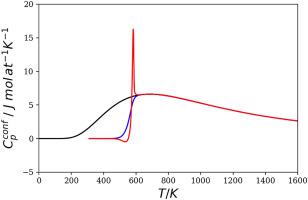Calphad ( IF 1.9 ) Pub Date : 2020-12-23 , DOI: 10.1016/j.calphad.2020.102238 P. Benigni

|
A coupled thermodynamic/kinetic CALPHAD type modeling of the glass transition for a glass forming unary substance is proposed. In this quantitative modeling, the vibrational contributions to the thermodynamic functions of the crystal and liquid/glass phases are classically modeled using weighed sums of Einstein functions while the configurational contributions to the liquid/glass phase functions are described using a single internal variable within the frame of the ideal two-state model. The freezing kinetics of this internal variable on cooling is calculated with an Adam-Gibbs logarithmic relaxation law. The model is applied to the boron oxide B2O3 and, after a numerical optimization of the parameters, is shown to well represent the hysteresis loop of the heat capacity detected by DSC in the glass transition range during cooling/reheating cycles at various rates. The model also allows to calculate the fictive temperature and residual or zero-point entropy of the glass.
中文翻译:

CALPHAD对纯物质的玻璃化转变进行建模,将热力学和松弛动力学耦合
提出了用于玻璃形成一元物质的玻璃化转变的热力学/动力学CALPHAD耦合模型。在这种定量建模中,使用爱因斯坦函数的加权总和来经典地建模对晶体和液相/玻璃相的热力学函数的振动贡献,而使用框架内的单个内部变量描述对液相/玻璃相函数的构型贡献。理想的二态模型。使用Adam-Gibbs对数松弛定律计算该内部变量在冷却时的冻结动力学。该模型应用于氧化硼B 2 O 3在对参数进行数值优化之后,它可以很好地代表在各种速率的冷却/加热循环期间,DSC在玻璃化转变范围内通过DSC检测到的热容的磁滞回线。该模型还允许计算虚拟温度和玻璃的残留或零点熵。











































 京公网安备 11010802027423号
京公网安备 11010802027423号